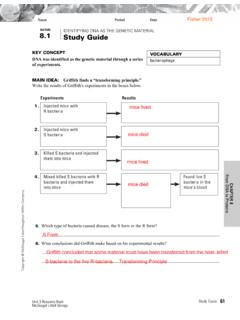Transcription of Tone and Mood - inetTeacher.com
1 Tone and Mood Watch out! Tone and mood are similar!! Tone is the author s attitude toward the writing (his characters, the situation) and the readers. A work of writing can have more than one tone. An example of tone could be both serious and humorous. Tone is set by the setting, choice of vocabulary and other details. Mood is the general atmosphere created by the author s words. It is the feeling the reader gets from reading those words. It may be the same, or it may change from situation to situation. Read more about it! Authors set a TONE or MOOD in literature by conveying an emotion or emotions through words.
2 The way a person feels about an idea, event, or another person can be quickly determined through facial expressions, gestures and in the tone of voice used. MOOD: (sometimes called atmosphere) the overall feeling of the work Mood is the emotions that you (the reader) feel while you are reading. Some literature makes you feel sad, others joyful, still others, angry. The main purpose for some poems is to set a mood. Writers use many devices to create mood, including images, dialogue, setting, and plot. Often a writer creates a mood at the beginning of the story and continues it to the end.
3 However, sometimes the mood changes because of the plot or changes in characters. Examples of MOODS include: suspenseful, joyful, depressing, excited, anxious, angry, sad, tense, lonely, suspicious, frightened, disgusted TONE: the way feelings are expressed Tone is the attitude that an author takes toward the audience, the subject, or the character. Tone is conveyed through the author's words and details. Use context clues to help determine the tone. In literature an author sets the tone through words. The possible tones are as boundless as the number of possible emotions a human being can have.
4 Has anyone ever said to you, "Don't use that tone of voice with me?" Your tone can change the meaning of what you say. Tone can turn a statement like, " You're a big help!" into a genuine compliment or a cruel sarcastic remark. It depends on the context of the story. Words That Describe Tone Amused Humorous Pessimistic Angry Informal Playful Cheerful Ironic Pompous Horror Light Sad Clear Matter-of-fact Serious Formal Resigned Suspicious Gloomy Optimistic Witty Words That Describe Mood Fanciful Melancholy Frightening Mysterious Frustrating Romantic Gloomy Sentimental Happy Sorrowful Joyful Suspenseful IDENTIFYING TONE & MOOD For each example identify the tone, what context clues are used to convey the tone, and the overall mood of the sentence.
5 1. Bouncing into the room, she lit up the vicinity with a joyous glow on her face as she told about her fianc and their wedding plans. Tone _____ Context Clues _____ Mood _____ 2. She huddled in the corner, clutching her tattered blanket and shaking convulsively, as she feverishly searched the room for the unknown dangers that awaited her. Tone _____ Context Clues _____ Mood _____ 3. Bursting through the door, the flustered mother screamed uncontrollably at the innocent teacher who gave her child an F. Tone _____ Context Clues _____ Mood _____ 4. Drawing the attention of his classmates as well as his teacher, the student dared to experiment with his professor s intelligence by interrogating him about the Bible.
6 Tone _____ Context Clues _____ Mood _____ 5. He furtively glanced behind him, for hear of his imagined pursuers, then hurriedly walked on, jumping at the slightest sound even of a leaf crackling under his own foot. Tone _____ Context Clues _____ Mood _____ 6. Gently smiling, the mother tenderly tucked the covers up around the child s neck, and carefully, quietly, left the room making sure to leave a comforting ray of light shining through the opened door should the child wake. Tone _____ Context Clues _____ Mood _____ 7. The laughing wind skipped through the village, teasing trees until they danced with anger and cajoling the grass into fighting itself, blade slapping blade, as the silly dog with golfball eyes and flopping, slobbery tongue bounded across the lawn.
7 Tone _____ Context Clues _____ Mood _____













